Design and life cycle cost analysis of a SAPV system to electrify a rural area household in India
Mohd. Arif1 * and M. Emran Khan2
DOI: http://dx.doi.org/10.12944/CWE.5.1.15
This paper presents a study on a stand-alone photovoltaic (SAPV) system to provide the required electricity for a single residential household in India. The complete design of the suggested system is carried out, such that the site radiation data and the electrical load data of a typical household in the considered site are taken into account during the design steps. Also, the life cycle cost (LCC) analysis is conducted to assess the economic viability of the system. The results of the study encouraged the use of the PV systems to electrify the rural sites of India.
Copy the following to cite this article:
Arif M, Khan M. E. Design and life cycle cost analysis of a SAPV system to electrify a rural area household in India. Curr World Environ 2010;5(1):101-106 DOI:http://dx.doi.org/10.12944/CWE.5.1.15
Copy the following to cite this URL:
Arif M, Khan M. E. Design and life cycle cost analysis of a SAPV system to electrify a rural area household in India. Curr World Environ 2010;5(1):101-106. Available from: http://www.cwejournal.org/?p=1114
Download article (pdf)
Citation Manager
Publish History
Select type of program for download
| Endnote EndNote format (Mac & Win) | |
| Reference Manager Ris format (Win only) | |
| Procite Ris format (Win only) | |
| Medlars Format | |
| RefWorks Format RefWorks format (Mac & Win) | |
| BibTex Format BibTex format (Mac & Win) |
Article Publishing History
| Received: | 2010-01-05 |
|---|---|
| Accepted: | 2010-03-12 |
Introduction
Photovoltaic (PV) energy production is recognized as an important part of the future energy generation mix.1 Because it is non-polluting, free in its availability, and is of high reliability. Therefore, these facts make the PV energy resource attractive for many applications, especially in rural and remote areas of most of the developing countries.2
India lies in the sunny belt of the world. The scope for generating power and thermal applications using solar energy is huge. Most parts of India get 300 days of sunshine a year, which makes the country a very promising place for solar energy utilization.3 The daily average solar energy incident over India varies from 4 to 7 kW h/m2 with the sunshine hours ranging between 2300 and 3200 per year, depending upon location.4 The technical potential of solar energy in India is huge. The country receives enough solar energy to generate more than 500,000 TW h per year of electricity, assuming 10% conversion efficiency for PV modules. It is three orders of magnitude greater than the likely electricity demand for India by the year 2015.
This paper presents a study on the design and economical analysis of a stand-alone PV system to provide the required electrical energy for a single residential household in India. The Indian location selected is Delhi.
The household pv system configuration
Fig. (1) shows the suggested block diagram of the household stand-alone PV system. Where, the function of the PV array is to convert the sunlight directly into DC electrical power and that of the battery is to store the excess power through using the battery charger. The inverter is used to convert the DC electrical power into AC power; to match the requirements of the common household AC appliances.
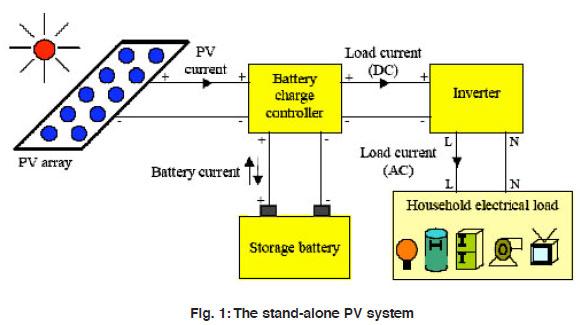 |
Figure 1: The stand-alone PV system Click here to view figure |
Site meteorological data
To predict the performance of a PV system in a site, it is necessary to collect the meteorological or environmental data for the site location under consideration. Indian Meteorological Department, Pune5 is a good source for these data. The monthly average daily solar radiation data incident on horizontal plane of the site is shown in Fig. (2). It is clear from the figure that solar energy incident in the considered site is very high especially during the summer months, where it reaches 7 kWh/m2/ day on horizontal plane.
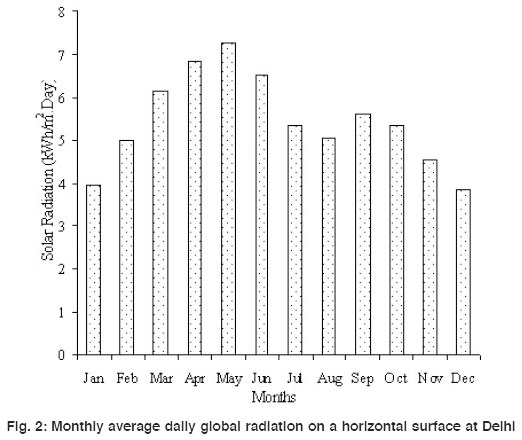 |
Figure 2: Monthly average daily global radiation on a horizontal surface at Delhi Click here to view figure |
average daily solar radiation data incident on horizontal plane of the site is shown in Fig. (2). It is clear from the figure that solar energy incident in the considered site is very high especially during the summer months, where it reaches 7 kWh/m2/ day on horizontal plane.
PV System Design
To design a stand-alone PV system for the considered household, the following steps are required.
The Average Daily Solar Energy Input
Fig. (2) can be used to calculate the average daily solar energy input over the year (Gav) on a south facing surface tilted at an angle equal to the site latitude to be about 6.62 kWh/m2/day.
The Average Daily Load Demand
The average daily load demand EL can be calculated from Fig. (3), to be 5500 Wh/day.
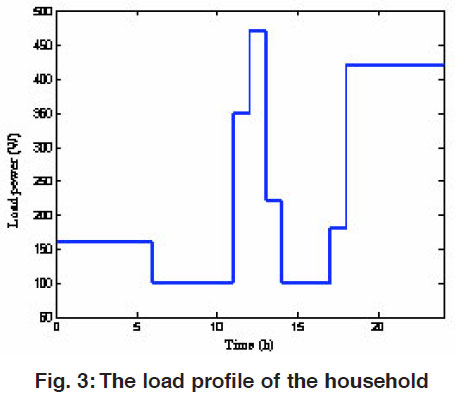 |
Figure 3: The load profile of the household Click here to view figure |
Sizing of the PV Array
The size of the PV array, used in this study, can be calculated by the following equation [6]:
 ...(1)
...(1)
Where
Gav is average solar energy input per day TCF is temperature correction factor PV is PV efficiency
out is battery efficiency ( ) ´inverter efficiency ( Inv )
If the cell temperature is assumed to reach 60 oC in the field, then the temperature correction factor (TCF) will be 0.8 as indicated in [7]. Assuming = 12% and = 0.85×0.9 = 0.765. Thus, using Eq. (1) the PV area is 11.3 m2.
The PV peak power, at peak solar insolation (PSI) of 1000 W/m2, is thus given by [7, 8]:
 ...(2)
...(2)
The selected modules are mono-crystalline silicon, with the following specifications at standard test conditions (i.e., 1000 W/m2 and 25 oC)
- Peak power: 23.2 WP
- Peak-power voltage: 9.6 V
- Peak-power current: 2.4167 A
​​​​​B Thus, 60 modules are used to supply the required energy for the residential house. The series and parallel configuration of the resulted PV array can be adjusted according to the required DC bus voltage and current, respectively. If the DC bus voltage is chosen to be 24 V, then 3 modules will be connected in series and 20 strings (each of 3 modules in series) will be connected in parallel.
 |
Table 1: The Household Load Data Click here to view table |
Sizing of the Battery
The storage capacity of the battery can be calculated according to the following relation [8, 9]:
 ...(3)
...(3)Where
NC is largest number of continuous cloudy days of the site. DOD is maximum permissible depth of discharge of the battery. The largest number of continuous cloudy days NC in the selected site is about 4 days. Thus, for a maximum depth of discharge for the battery DOD of 0.8, the storage capacity becomes 35948 Wh (Eq. (3)). Since, the selected DC bus voltage is 24 V, then required ampere-hours of the battery = 35948/24 ~ 1500 Ah. If a single battery (Vision 6FM250D) of 12 V and 250 Ah is used, then 2 batteries are connected in series and 3 strings of batteries are connected in parallel to give an overall number of 6 batteries.
 |
Table 2: The Used Cost Data of All Items Click here to view table |
Design of the Battery Charge Controller
The battery charge controller is required to safely charge the batteries and to maintain longer lifetime for them. It has to be capable of carrying the short circuit current of the PV array. Thus, in this case, it can be chosen to handle 50 A (i.e., 2.5 A × 20) and to maintain the DC bus voltage to about 24 V.
Design of the Inverter
The used inverter must be able to handle the maximum expected power of AC loads. Therefore, it can be selected as 20% higher than the rated power of the total AC loads that presented in Table 1. Thus the rated power of the inverter becomes 1020 W. The specifications of the required inverter will be 1020 W, 24 VDC, 220 VAC, and 50 Hz.
Life Cycle Cost Analysis
In this section the life cycle cost (LCC) estimation of the designed stand-alone PV system is discussed. The LCC of an item consists of the total costs of owning and operating an item over its lifetime, expressed in today’s money10-15.
The costs of a stand-alone PV system include acquisition costs, operating costs, maintenance costs, and replacement costs. All these costs have the following specifications:
- The initial cost of the system (the capital cost) is high.
- There are no fuel costs.
- Maintenance costs are low.
- Replacement costs are low (mainly for batteries).
The LCC of the PV system includes the sum of all the present worths (PWs) of the costs of the PV modules, storage batteries, battery charger, inverter, the cost of the installation, and the maintenance and operation cost (M&O) of the system. The details of the used cost data for all items are shown in Table 2 [7, 12-14].
The lifetime N of all the items is considered to be 20 years, except that of the battery which is considered to be 5 years. Thus, an extra 3 groups of batteries (each of 6 batteries) have to be purchased, after 5 years, 10 years, and 15 years, assuming an inflation rate i of 3% and a discount or interest rate d of 10%. Therefore, the PWs of all the items can be calculated as follows [10, 11]:
- PV array cost CPV = 5×60×23.2 = $6960
- Initial cost of batteries CB = 1.705 ´ 1500 = $2557.5
- The PW of the 1st extra group of batteries (purchased after N = 5 years) CB1PW can be calculated, to be $1840.93, from
 ...(4)
...(4)- The PW of the 2nd extra group of batteries (purchased after N = 10 years) CB2PW and that of the 3rd extra group (purchased after N = 15 years) CB3PW are calculated, using Eq. (4), to be $1325.14 & $953.86, respectively.
- Charger cost CC = 5.878 ´ 50 = $293.9
- Inverter cost CInv = 0.831 ´ 1020 = $847.62
- Installation cost CInst = 0.1 ´ 6960 = $696
- The PW of the maintenance cost CMPW can be calculated to be $1498.35, using the maintenance cost per year (M/yr) and the lifetime of the system (N = 20 years), from [12];
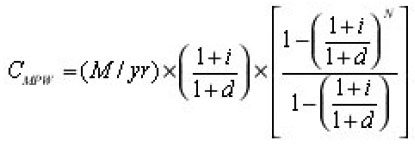 ...(5)
...(5)Therefore, the LCC of the system can be calculated, to be $16973.3, from:
 ...(6)
...(6)It is sometimes useful to calculate the LCC of a system on an annual basis. The annualized LCC (ALCC) of the PV system in terms of the present day dollars can be calculated, to be $1476.51/yr, from [9,10]:
​​​​​
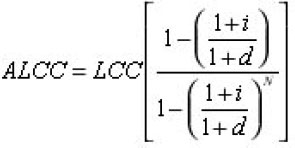 ...(7)
...(7)Once the ALCC is known, the unit electrical cost (cost of 1 kWh) can be calculated, to be $0.74/ kWh, from;
 ...(8)
...(8)Therefore, in remote sites that are too far from the Indian power grid, the PV installers are encouraged to sell the electricity of their PV systems at a price not lower than $0.74/kWh to earn a profit. It is to be noted, here, that although this price is very high compared to the current unit cost of electricity in India ($0.1/kWh), this price will drop to $0.49/kWh if the future initial cost of the PV modules drops to $0.1/WP. At the same time, if the future unit cost of electricity in India becomes five times its current value, due to the rapid increase in the conventional fuel prices, therefore PV energy generation will be promising in the future household electrification (in India) due to its expected future lower unit electricity cost, efficiency increase, and clean energy generation compared to the conventional utility grid.
Conclusion
Electrification of remote and rural sites worldwide is very important especially in the developing countries like India. The photovoltaic systems are considered as the most promising energy sources for these sites, due to their high reliability and safety. They represent, at the same time, a vital and economic alternative to the conventional energy generators. An electrification study for a single residential household in a remote rural site of India is carried out using a stand-alone PV system. This study presents the complete design and the life cycle cost analysis of the PV system. The results of the study indicate that electrifying a remote rural household using PV systems is beneficial and suitable for long-term investments, especially if the initial prices of the PV systems are decreased and their efficiencies are increased.
References
- Ramachandrn, J.; Pearsall, N.M.; Putrus, G.A. In Reduction in Solar Radiation Fluctuation by Spatial Smoothing Effect, Proceedings of the 19th European Photovoltaic Solar Energy Conference, Paris, France, (2004) 3: 2900-2903.
- Ishengoma, F.M.; Norum, L.E. In Design and Implementation of a Digitally Controlled Stand-Alone Photovoltaic Power Supply, Proceedings of the Nordic Workshop on Power and Industrial Electronics (NORPIE/ 2002), Stockholm, Sweden, (2002) 1-5.
- Survey of renewable energy in India. TERI (Tata Energy Research Institute), New Delhi (2001).
- Renewable energy in India. MNES report, Government of India (2001).
- Mani, A., Handbook of Solar Radiation Data for India. Allied Publishers, New Delhi, India (1980).
- Vankeleom, J.; Dufourd, F.; Saleh, L.A. In ELVIRA: A Software for Rural Electrification in Developing Countries - Application for the Use of Photovoltaic Energy in Egypt, Proceedings of the 19th European Photovoltaic Solar Energy Conference, Paris, France, (2004) 3: 3452-3455.
- Taylor, R.; Abulfotuh, F. Photovoltaic Electricity in Egypt, Project Brief. http:// www.rsvp.nrel.gov (accessed 2005).
- Alamsyah, T.M.I.; Sopian, K.; Shahrir, A. In Technoeconomics Analysis of a Photovoltaic System to Provide Electricity for a Household in Malaysia, Proceedings of the International Symposium on Renewable Energy: Environment Protection & Energy Solution for Sustainable Development, Kuala Lumpur, Malaysia, (2003) 387-396.
- Mahmoud, M.M.; Ibrik, I.H. Techno-economic feasibility of energy supply of remote villages in palestine by PV-systems, diesel generators and electric grid. Renewable Sustainable Energy Rev., (2006) 10: 128-138.
- Wenham, S.R.; Green, M.A.; Watt, M.E. Applied Photovoltaics, Center for Photovoltaic Devices and Systems: Australia (1994).
- Markvart, T. Solar Electricity, John Wiley & Sons: New York (1994).
- Messenger, R.; Ventre, J. Photovoltaic Systems Engineering, CRC Press LLC: Boca Raton, Florida, USA, (2000).
- Celik, A.N. Effect of different load profiles on the loss-of-load probability of stand-alone photovoltaic systems. Renewable Energy, (2007) 32: 2096-2115.
- Ajan, C.W.; Ahmed, S.S.; Ahmed, H.B.; Taha, F.; Zin, A.A.B.M. On the policy of photovoltaic and diesel generation mix for an offgrid site: East Malaysian Perspectives. Solar Energy, (2003) 74: 453-467.
- Celik, A.N. Present status of photovoltaic energy in turkey and life cycle techno-economic analysis of a grid-connected photovoltaic house. Renewable Sustainable Energy Rev., (2006) 10: 370-387.






